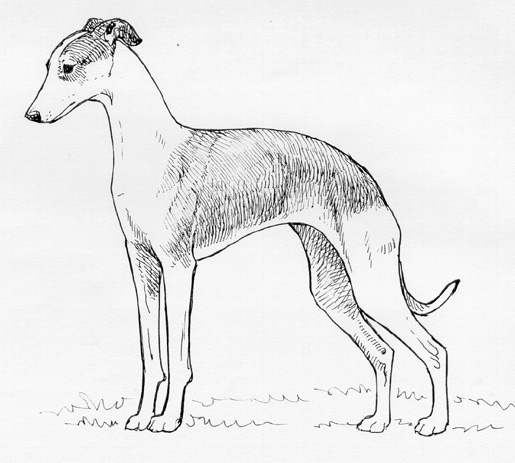Italian Greyhound
Companion Dog Group
The goals and purposes of this breed standard include: to furnish guidelines for breeders who wish to maintain the quality of their breed and to improve it; to advance this breed to a state of similarity throughout the world; and to act as a guide for judges.
Breeders and judges have the responsibility to avoid any conditions or exaggerations that are detrimental to the health, welfare, essence and soundness of this breed, and must take the responsibility to see that these are not perpetuated.
Any departure from the following should be considered a fault, and the seriousness with which the fault should be regarded should be in exact proportion to its degree and its effect upon the health and welfare of the dog and on the dog’s ability to perform its traditional work.
History
The Italian Greyhound descends from the small sighthounds of ancient Egypt. The Romans further developed the breed after its arrival on the Italian peninsula around the 5th century BCE. Its great popularity in Italy and other Mediterranean countries during the Middle Ages and the Renaissance gave the breed its current name. The Italian Greyhound has been prized by nobility throughout history. Today, the Italian Greyhound is a small sighthound that is mostly valued as a loving companion.
The Italian Greyhound was recognized by the United Kennel Club in 1948.
General Appearance
As suggested by its name, the Italian Greyhound is very similar to the much larger Greyhound, although they are much smaller and more slender in all proportions. The Italian Greyhound is a breed of supreme elegance and grace.
Characteristics
Intelligent and affectionate, but sensitive and may be reserved with strangers.
Head
Long and narrow. The stop is slight. The distance from the occiput to the stop is equal to the distance from the stop to the tip of the nose.
SKULL
Narrow and almost flat.
MUZZLE
The same length as the skull and tapering. The lips are thin and tight, with darkly pigmented edges.
TEETH
A full complement of strong, white teeth meet in a scissors bite.
Serious Faults: Overshot or undershot bite.
EYES
Expressive, medium size eyes are dark in color and have pigmented eye rims. However, pied, white, white-face or split-face dogs are not to be faulted for lack of full eye rim pigmentation.
Fault: Very light eyes.
Serious Faults: Wall eyes.
NOSE
Dark, preferably black, but may be brown or blue in harmony with the color of the coat.
Serious Faults: Dudley or butterfly nose.
EARS
The small, delicate, rose ears are fine in texture. They are thrown back and folded, except when the dog is alert, when they are carried at right angles to the head.
Serious Faults: Erect ears. Button ears.
Neck
Long, slender and slightly arched. No dewlap. Ewe-neck is undesirable.
Forequarters
The shoulder blades are slightly sloping and form an open angle with the upper arm. The muscles are lean.
FORELEGS
The forelegs are long, straight and lightly boned. The distance from the ground to the elbow is slightly greater than the distance from the elbow to the withers. The pasterns are slightly sloping. Dewclaws may be removed.
Body
The medium length body is short coupled, with the extra length being in the rib cage. The chest is narrow, deep and let down as close to the elbows as possible. The withers are high. The topline shows a slight rise, with the highest point at the start of the loin, dropping harmoniously into the sloping croup, creating a definite tuck-up at the flanks.
Hindquarters
HIND LEGS
The hind legs are long and parallel when viewed from behind. The thighs are long and lean with distinct muscling. The stifle is well bent. The hocks are well let down.
Feet
Hare shaped, with well arched toes.
Tail
The slender tail tapers to a curved end; it is long enough to reach the hock. It is set and carried low.
Serious Faults: Short tail. Gay tail. Ring tail.
Coat & Skin
The short, glossy, satin-like hair is fine in texture and soft to the touch. The skin is fine and supple.
Color
All colors and markings are acceptable except for the following (which are disqualifications): brindle markings; tan markings, such as those usually found on black and tan dogs of other breeds.
Disqualifications: Albinism. Brindle markings. Tan marking, such as those found on black and tan dogs of other breeds.
Height
The ideal height at the withers measures from 13 to 15 inches.
Serious Fault: Any deviation above or below the height range.
Gait
Distinctive action is high stepping and free, the foreleg is lifted with a slight bend at the wrist rather than a goose step. Both front and rear legs move forward in a straight line with reach in front and drive from the rear. Both front and rear legs may converge slightly as speed increases but should not cross. Movement is sound, elegant and smooth, not choppy or hackney-like.
Faults: Hackney action. Crossing front or rear.
Disqualifications
(A dog with a Disqualification must not be considered for placement in a conformation event, and must be reported to UKC.)
Unilateral or bilateral cryptorchid.
Viciousness or extreme shyness.
Albinism.
Brindle markings.
Tan marking, such as those found on black and tan dogs of other breeds.

Looking for a Dog?
Find a dog that will fit your family.
Note: The breeders on this list are not endorsed by UKC.
Revised March 1, 2008
©Copyright 1992, United Kennel Club
